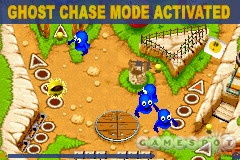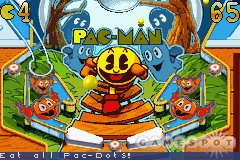Pac-Man Pinball Advance does a clever job of incorporating the characters and themes from Namco's Pac-Man franchise into a traditional pinball video game. Unfortunately, that's about the only thing this game does right. Between the broken physics and dark graphics--not to mention the egregious lack of a high-score list--Pac-Man Pinball Advance suffers from a litany of problems.

The overall concept is a good one. The game takes the characters from the Pac-Man franchise and integrates them into a pinball game that involves two different tables, multiple power-up items, and a small assortment of minigames. There are dots to collect on each table and power pellets to eat, which, just like the power pellets in the original Pac-Man arcade game did, give our round yellow hero the ability to chase after and devour the four ghosts wandering around the table. By entering the Pac Prof's house on each table, you'll be able to exchange the dots you've collected for power-up items, such as ball savers, multiballs, and bonus multipliers. These items have a Pac-Man theme as well. For instance, the multiball looks like Ms. Pac-Man. Every so often, you'll enter the Pac Prof's house and find yourself participating in a minigame, which could take the form of a standard dot-collecting bonus room, a vertically scrolling shoot-'em-up, or even a classic Pac-Man maze.
Sadly, Pac-Man Pinball Advance is broken in a myriad of ways. The physics, the collision detection, and even the graphics actually get in the way of making headway. The controls are easy enough. You use the left D pad and the A button to control the left and right flippers, respectively, while the other buttons let you bump the table. When you use one of the flippers, however, it's anyone's guess as to where the ball is going to end up. Sometimes, the ball will speed down the lower ramp and you'll activate a flipper, only to watch it gently roll into one of the gutters. Other times, the ball will trickle down the lower ramp and go absolutely flying when you bump it off of the fat side of the flipper, where there shouldn't be any leverage. Momentum and angle also don't seem to have any bearing on how the ball bounces off of walls and bumpers. Basically, the physics are random. To make matters worse, the collision detection isn't always reliable. At times, the ball will pass right through a pin or fail to bounce off one of the bumpers.
Even the graphics make the game harder to play. Each of the two tables--four if you count the classic color schemes--is roughly the height of two screens and based on a particular theme, such as the Wild West or the Pac people's forest village. Pac-Man's four ghostly foes--Inky, Blinky, Pinky, and Clyde--sit below the flippers and subsequently scurry around the table whenever you pick up a power pellet. Just to make the license even more obvious, the ball is yellow and painted to look like Pac-Man. These details are nice, but unfortunately, the graphics are so dark and grainy that it's impossible to enjoy them. The ball is easy to lose track of, especially on the two classic tables where the backgrounds are dark blue with yellow or brown accents.
The audio won't win any awards either, but at least it doesn't get in the way of a person's ability to actually play the game. Most of the sound effects for actions such as collecting dots, activating power pellets, and eating ghosts were lifted straight out of the Pac-Man arcade game. Throughout it all, a single piece of dramatic music loops constantly. It's a bit scary and out of place, but not particularly bad.

When you think about it, it almost seems like the development team that made Pac-Man Pinball Advance didn't have much hands-on experience with real pinball tables. If they had, they'd easily have noticed how inappropriate the physics were and perhaps would've realized that the graphics needed to be better defined. Also, you don't have to be a pinball wizard to understand that pinball is all about setting high scores and establishing bragging rights. The fact that Pac-Man Pinball Advance doesn't record high scores is inexcusable. This one oversight pretty much eliminates what little replay value the game had left.
Just like all of the other budget-priced GBA games that Namco has published lately, Pac-Man Pinball Advance is rife with problems that any decent quality-control process would have made right. The game was rushed out the door to make a quick buck and it clearly shows.